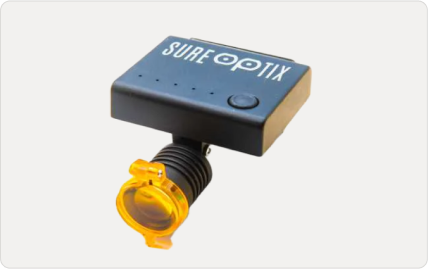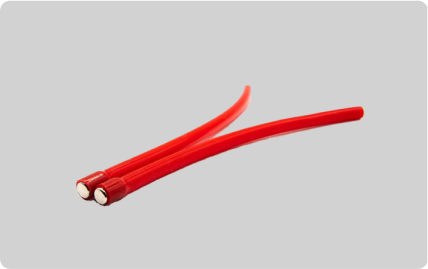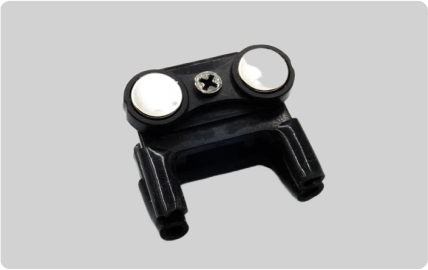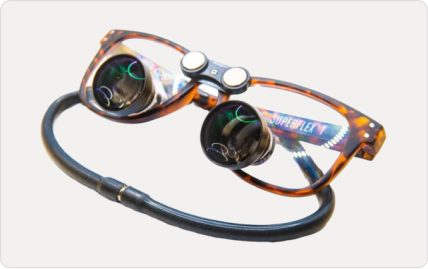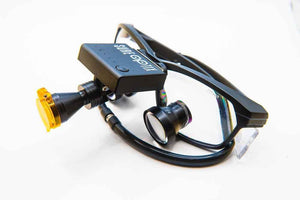
Choosing the Best Dental Loupes: What Dentists Need to Know

Dentistry is an amalgamation of immaculate skills and mastery of art. Dentists work in small holes and cavities that require extreme precision and skills. Unfortunately, the presence of liquids in these cavities during procedures further obscures the dentist’s vision.
But that’s not an issue anymore! The introduction of dental loupes has significantly eased the difficulties of dentists, allowing them to visualize micro-level objects and spaces, resulting in improved accuracy and treatment longevity and minimizing the risk of musculoskeletal disorders among dentists 1. Another study in 2020 2. concluded that dentists who used dental loupes with 2.5✕ magnification had significantly higher tooth preparation precision than those working with the naked eye.
Dental loupes have become highly popular among US dentists, with over 50% of American dentists already using them in their routine practice 1. With increased popularity and demand, different brands and designs of dental loupes are now available in the markets. If you’re also considering incorporating magnification devices such as dental loupes in your practice but cannot decide which one to choose, you have come to the right place.
Here are some guidelines that will help you select the best loupes for dental practice.
Magnification
Dental loupes come in different magnifications - from 2.5X to 6X - each suitable for a particular dental procedure. While suitable magnification may vary from dentist to dentist, the generic recommendations for magnification based on different specialties are:
- For general dentists, hygienists, and implant dentists - 2.5X - 3.5X
- For crown and bridge work and endodontic treatment - 3.5 - 6X
- For dental technicians and laboratory work - 4X - 6X
Most dental loupes offer a range of magnifications you can choose from, depending on your intended procedure and specialty. Typically, Galilean loupes offer lower magnification (2.5X - 3.5X) than prismatic ones (3.5X - 6X).
Resolution
The resolution of dental loupes is their ability to distinguish between two closely spaced objects. Simply put, the higher the resolution of your dental loupes, the better you can visualize small objects and spaces during procedures. Ideally, one should go with dental loupes with the highest possible resolution affordable under the available budget.
Depth of Field
The depth of the view (DOV) is the range to which objects you are viewing remain in focus. It is essential as it helps dentists maintain a desirable posture and reduces fatigue.
A generous DOV ensures that you can see deeper, farther, and greater detail without the need to adjust your view or posture. DOV relates to the magnification and working range of the loupes.
Field of View
Field of view (FOV) is the area visible through the loupes. For example, loupes with a higher field of view will show multiple teeth or a wider area but will have a lower magnification. On the other hand, loupes with a lower field of view will show a lesser area but have a higher magnification.
Choosing the FOV is a matter of personal preference for many dentists. However, loupes with a greater FOV are suitable for dentists who have just started them, while more experienced dentists may use loupes with a lower FOV as they provide a higher magnification and detail.
Light
Lighting is among the most crucial factors when selecting loupes. Loupes without good lighting only magnify darkness and fail to show the real image. Loupes ensuring a well-lit oral cavity will help dentists make an accurate diagnosis, perform accurate procedures, and alleviate eye strain.
In most dental loupes, the light is mounted on the bridge of the frames between the eyes, allowing for multiple adjustment points. Some designs may also incorporate a wire into the frame, which attaches to a battery. However, this may increase the weight of the loupes, affecting their comfort. So, it is essential to go for a lightweight loupe design, especially when the light rests on the bridge of the nose.
Another factor to consider is the color of the light beam. Ideally, the light color should be as close to the natural daylight as possible, with a color temperature in the range of 5500k– 5700k. This will allow you to visualize the true color of the viewed objects.
Finally, you should buy surgical loupes that have a long-lasting battery that is enough to last for an entire workday without the need for charging.
Style and Design
Dental loupe styles and designs have come a long way over the years, from being bulky to lightweight, slim, sporty, and stylish. So, you can choose from various loupe styles based on your preference.
Another factor is the design of the loupes, whether you prefer the flip-up or through-the-lens (TTL) loupes. If you’re unsure of the difference between the two, flip-up loupes can be flipped up to bring them out of sight. On the other hand, the optical barrels in TTL loupes are attached directly to the carrier lens. Flip-up lenses have the advantage of offering an adjustable angle of declination, whereas TTL surgical loupes offer all the benefits of custom-fit loupes. Again, the choice is a matter of personal preference and specialty.
Now that you know what to look for in good dental loupes, the next question is where to buy high-quality ones. Don’t worry, SureOptix has got you covered! Whether you need flip-up or TTL, elegant-looking or sporty, stylish ones, we have just the loupes you need! That’s not all! Our loupes are not only high-quality and cost-effective but come with a 30-day trial and money-back guarantee.

If you’re having difficulty choosing your loupes, let our qualified consultants help you find a design that best suits your needs. Once you have decided, you can simply order online from the comfort of your home and get your surgical loupes delivered through priority mail. You can also get in touch with our round-the-clock customer care service by calling or sending an email.
Order your surgical loupes today and enter an era of convenience, postural comfort, precision, and surgical accuracy.
References
- Aboalshamat, Khalid, et al. "Practices and attitudes of dental loupes and their relationship to musculoskeletal disorders among dental practitioners." International Journal of Dentistry 2020 (2020): 1-7.
- Eichenberger, Martina, et al. "Effect of magnification on the precision of tooth preparation in dentistry." Operative Dentistry 43.5 (2018): 501-507.






